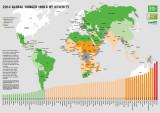Land Library Search
Through our robust search engine, you can search for any item of the over 73,000 highly curated resources in the Land Library.
If you would like to find an overview of what is possible, feel free to peruse the Search Guide.
/ library resources
Showing items 10 through 18 of 297.With one more year before the 2015 deadline for achieving the Millennium Development Goals, the 2014 Global Hunger Index report offers a multifaceted overview of global hunger that brings new insights to the global debate on where to focus efforts in the fight against hunger and malnutrition.
Der Welthunger-Index (WHI) 2014 stellt die nationale, regionale und weltweite Hungersituation zum neunten Mal in jahrlicher Folge multidimensional dar.
The Global Hunger Index (GHI) is based on three equally weighted indicators: > Undernourishment: the proportion of undernourished people as a percentage of the population (reflecting the share of the population with insufficient caloric intake); > Child underweight: the proportion of childr
Le rapport de l’Indice de la faim dans le monde 2014 – neuvieme edition – propose une mesure multidimensionnelle de la faim au niveau national, regional et mondial.
Successful development experiences have demonstrated the greater efficiency achieved with a growth strategy based on small and medium-scale farmers (SMFs).
Agricultural production in Cambodia is concentrated in the northwestern districts bordering Thailand, on the central plains surrounding the Tonle Sap Lake and its river systems, along the Mekong and Bassac rivers towards the Mekong delta, and in the northern and northeastern provinces.
The type of agrarian structure employed to produce tropical commodities affects many dimensions of land use, such as ownership inequality, overlapping land rights and conflicts, and land use changes.
Rural change in Cambodia manifests itself in rapidly declining land availability for the smallholder sector, posing the question of how farmers may be able to deal with limited access to land.
Cambodia is engaged in profound societal and economic changes usually referred to as “agrarian transition”.





